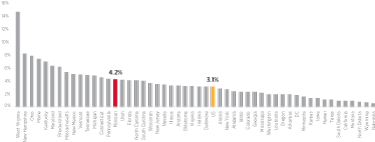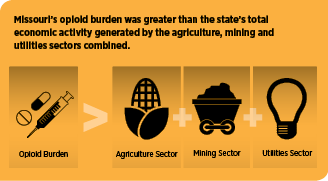Expert

Dave Dillon
Actions
Type
Topic
- Opioids
- Substance Use Disorder
Tags
JEFFERSON CITY, Mo. — New research from the Hospital Industry Data Institute finds that the total economic cost of the opioid crisis in Missouri was $12.6 billion in 2016, with the costs associated with overdose deaths accounting for 96 percent of the total economic burden. Researchers found the opioid overdose mortality rate in Missouri nearly doubled between 2012 and 2016.
HIDI researchers used methods from the White House Council of Economic Advisors, and data released in late 2017 from the Centers for Disease Control and Prevention, to replicate the economic burden of the opioid crisis at the state level using updated mortality data from 2016. The analysis investigates the impact of two economic indicators — fatality costs, which are associated with premature mortality and nonfatality costs, which are associated with individuals with opioid use disorder and accrue from reduced productivity and increased consumption of health care and social services.
“The CEA tallied the national economic burden of opioid deaths and opioid use disorder finding a cost of $504 billion, or 2.8 percent of the nation’s gross domestic product in 2015,” said Herb B. Kuhn, Missouri Hospital Association president and CEO. “The Missouri rate exceeds the national average, where 4.2 percent of the state’s GDP is lost to opioid use disorder and opioid-related deaths.”
In 2016, the economic cost of the 921 opioid overdose deaths in Missouri was estimated at $12.1 billion. Costs associated with nonfatal opioid use disorder totaled $519 million. In 2016, on average, nearly three Missourians died each day from an opioid overdose. Missouri’s one-year increase over 2015 was 35 percent — six percentage points higher than the national increase of 29 percent.
“The devastating effect of the opioid crisis has contributed to an unprecedented drop in life expectancy and led to so-called ‘deaths of despair,’” Kuhn said. “Increasingly, this human tragedy is reflected in, and connected to, the alarming economic costs associated with the crisis. And, most of this economic burden is associated with fatality costs.”
The CDC found 42,000 Americans died from opioid-related deaths in 2016, for the first time accounting for more deaths than breast cancer in the U.S. In Missouri, 880 breast cancer deaths were reported in 2016, while 921 lives were lost to opioids the same year.
Research released last week by the Missouri Hospital Association illustrated another alarming trend. Beginning in 2010, drug-related deaths in Missouri exceeded fatalities from motor vehicle related accidents — a trend that continues throughout the decade.
The staggering economic cost to Missouri is equivalent to $1.4 million per hour, $24,000 per minute and $399 per second. In total, Missouri’s annual burden from the opioid crisis exceeds the economic activity generated by the agriculture, mining and utilities sectors combined.
“Although Missouri is making some progress in addressing the crisis — including Good Samaritan protections for assisting overdose victims and open access to naloxone to reverse opioid overdose — it’s clear that significant work remains to minimize the societal cost of opioid use disorder,” Kuhn said. “Other policies will be necessary, including more education, behavioral health and substance use disorder interventions, and coordination with law enforcement, among others.”
Decades-long investments in vehicle and roadway safety decreased the death toll on America’s roads. Education, screening and improved cancer-related care have reduced the number of women who die of breast cancer. Both efforts required coordinated efforts and long-term investments.
“Understanding the economic costs of the opioid crisis helps define the scope of the problem,” Kuhn said. “It’s clear that the benefit of investments in curbing opioid use disorder far outweigh the costs.”












